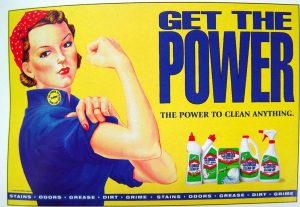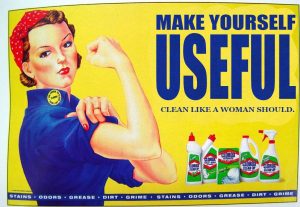Original Ad:

The woman in this picture depicted in the Clorox cleaning ad is an iconic symbol known as “Rosie the Riveter”. Originally, she was used as part of a propaganda campaign and represented women during World War II who joined the workforce producing munitions and war supplies (“Rosie The Riveter”, 2010). When the image of Rosie was first used, it followed with the caption “We Can Do It!” which aimed to motivate women who filled job positions that were predominately filled by men.
The intent of this advertisement for Clorox to motivate females in their duties is still present. However, the tasks that are implied from the original propaganda campaign compared to this cleaning ad are quite different. It stereotypes Rosie in a way where a women’s power is found in a more domestic setting. It reflects the historical role of women as housewives, where they are required to cook, clean and tend to the household while the husband is out in the workforce making money. It suggests that women will “Get The Power” when they use Clorox cleaning supplies to aid them in their domestic tasks.
At first glance, this ad appears to be breaking gender roles by empowering women. But in reality, this ad promotes sexism and reinforces gender roles. We can see that this ad takes away the masculine qualities of Rosie as she is seen wearing makeup, nail polish and a wedding ring suggesting that she is dependent on a significant other. It creates an unjust expectation for women by conveying the message that household tasks are a woman’s responsibility and that the man can sit back and relax rather than splitting these tasks among members of the household.
Jammed Ad:

In the jammed version of the Clorox ad, I changed the caption from “GET THE POWER” to “MAKE YOURSELF USEFUL” as an attempt to highlight the problems in how companies use women and gender roles to appeal to an audience. By changing the caption, it further degrades the symbolism that Rosie once had to empower women to contribute to war efforts by pushing themselves to work in factories to a woman who is only useful when she is cleaning.
I also changed the message underneath from “THE POWER TO CLEAN ANYTHING” to “CLEAN LIKE A WOMAN SHOULD” which serves to mock the role of women in the household by stating that it is their responsibility that women SHOULD clean.
The goal of the jammed version of the ad is to expose Clorox and their real intentions behind this ad. By saying “MAKE YOURSELF USEFUL” it subverts the original ad because it makes the reader realize what Clorox is really trying to sell which turns consumers off the idea of wanting to buy the product. The original ad tries to break gender roles by empowering women, but in reality, the ad is reinforcing them by making women feel the desire to buy cleaning products.
Instead of making women feel pressured and assimilating them into a role, I believe that a more effective way for Clorox to advertise would be to focus solely on their products. This can be done by advertising their product’s versatility for use in and out of the home as well as its effectiveness to remove stains and kill germs. That way, it will appeal to a wider audience and alleviates the pressure off of women to take on the responsibility of household tasks.
Works Cited
Rosie the Riveter – World War II – HISTORY.com. (2010). Retrieved October 21, 2016, from http://www.history.com/topics/world-war-ii/rosie-the-riveter
Picture Source: http://www.criticalcommons.org/Members/Lizcav/clips/clorox-get-the-power-advertisement-1/view